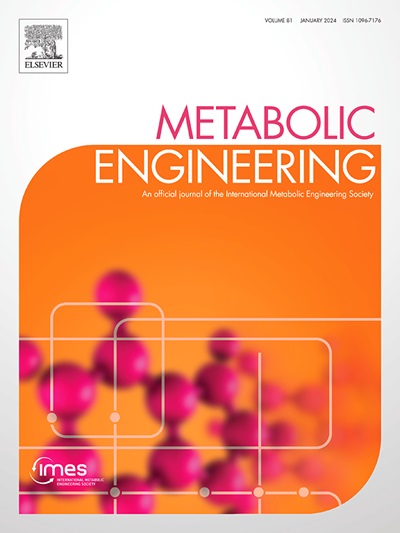Dynamic regulation combined with systematic metabolic engineering for high-level palmitoleic acid accumulation in oleaginous yeast
IF 6.8
1区 生物学
Q1 BIOTECHNOLOGY & APPLIED MICROBIOLOGY
引用次数: 0
Abstract
Palmitoleic acid (POA, C16:1Δ9) is widely recognized for its preventive and therapeutic effects in various chronic and cardiovascular diseases, but the current production practices based on plant extraction are both economically and ecologically unsustainable. Although Yarrowia lipolytica is capable of producing POA, it only accumulates to a small percentage of total fatty acids. The present study aimed to enhance the accumulation of POA by employing a two-layer engineering strategy, encompassing the modulation of the fatty acid profile and the promotion of the accumulation of POA-rich lipids. The fatty acid profile was subject to modulation through the engineering of the fatty acid metabolism by expressing heterologous specific fatty acid desaturases CeFat5 and implementing dynamic regulation based on a copper-responsive promoter. Then, the mechanism underlying this improvement of POA production capacity was elucidated. Finally, the POA-rich lipid accumulation ability was enhanced through engineering of the lipid metabolism by overexpressing the heterologous POA-specific triacylglycerol forming acyltransferase, introducing the artificial designed non-carboxylative malonyl-CoA production pathway, and preventing lipid degradation. The resulting optimized yeast strain achieved an impressive POA accumulation accounting for 50.62% of total fatty acids, marking a 37.7-fold improvement over the initial strain. Moreover, a record POA titer of 25.6 g/L was achieved in the bioreactor. Overall, this study introduces a framework for establishing efficient yeast platforms for the accumulation of valuable fatty acids.

产油酵母高水平棕榈油酸积累的动态调控与系统代谢工程相结合
棕榈油酸(POA, C16:1Δ9)因其对各种慢性和心血管疾病的预防和治疗作用而得到广泛认可,但目前基于植物提取的生产实践在经济和生态上都是不可持续的。虽然解脂耶氏菌能够产生POA,但它只积累到总脂肪酸的一小部分。本研究旨在通过采用两层工程策略来增强POA的积累,包括脂肪酸谱的调节和促进富含POA的脂质的积累。通过表达异源特异性脂肪酸去饱和酶CeFat5和基于铜响应启动子的动态调控,通过脂肪酸代谢工程对脂肪酸谱进行调节。在此基础上,分析了POA生产能力提高的机理。最后,通过脂质代谢工程,通过过表达异源poa特异性三酰基甘油形成酰基转移酶,引入人工设计的非羧化丙二酰辅酶a生产途径,防止脂质降解,增强富含poa的脂质积累能力。优化后的酵母菌获得了令人印象深刻的POA积累,占总脂肪酸的50.62%,比初始菌株提高了37.7倍。此外,在生物反应器中实现了创纪录的POA滴度25.6 g/L。总的来说,本研究介绍了一个框架,建立有效的酵母平台,积累有价值的脂肪酸。
本文章由计算机程序翻译,如有差异,请以英文原文为准。
求助全文
约1分钟内获得全文
求助全文
来源期刊

Metabolic engineering
工程技术-生物工程与应用微生物
CiteScore
15.60
自引率
6.00%
发文量
140
审稿时长
44 days
期刊介绍:
Metabolic Engineering (MBE) is a journal that focuses on publishing original research papers on the directed modulation of metabolic pathways for metabolite overproduction or the enhancement of cellular properties. It welcomes papers that describe the engineering of native pathways and the synthesis of heterologous pathways to convert microorganisms into microbial cell factories. The journal covers experimental, computational, and modeling approaches for understanding metabolic pathways and manipulating them through genetic, media, or environmental means. Effective exploration of metabolic pathways necessitates the use of molecular biology and biochemistry methods, as well as engineering techniques for modeling and data analysis. MBE serves as a platform for interdisciplinary research in fields such as biochemistry, molecular biology, applied microbiology, cellular physiology, cellular nutrition in health and disease, and biochemical engineering. The journal publishes various types of papers, including original research papers and review papers. It is indexed and abstracted in databases such as Scopus, Embase, EMBiology, Current Contents - Life Sciences and Clinical Medicine, Science Citation Index, PubMed/Medline, CAS and Biotechnology Citation Index.
 求助内容:
求助内容: 应助结果提醒方式:
应助结果提醒方式:


